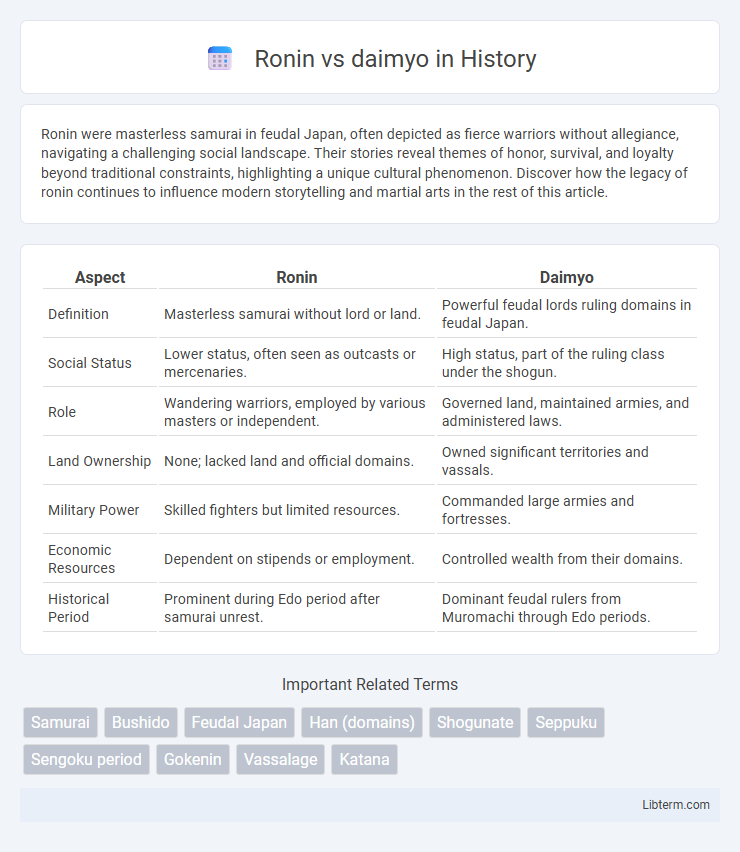Ronin were masterless samurai in feudal Japan, often depicted as fierce warriors without allegiance, navigating a challenging social landscape. Their stories reveal themes of honor, survival, and loyalty beyond traditional constraints, highlighting a unique cultural phenomenon. Discover how the legacy of ronin continues to influence modern storytelling and martial arts in the rest of this article.
Table of Comparison
| Aspect | Ronin | Daimyo |
|---|---|---|
| Definition | Masterless samurai without lord or land. | Powerful feudal lords ruling domains in feudal Japan. |
| Social Status | Lower status, often seen as outcasts or mercenaries. | High status, part of the ruling class under the shogun. |
| Role | Wandering warriors, employed by various masters or independent. | Governed land, maintained armies, and administered laws. |
| Land Ownership | None; lacked land and official domains. | Owned significant territories and vassals. |
| Military Power | Skilled fighters but limited resources. | Commanded large armies and fortresses. |
| Economic Resources | Dependent on stipends or employment. | Controlled wealth from their domains. |
| Historical Period | Prominent during Edo period after samurai unrest. | Dominant feudal rulers from Muromachi through Edo periods. |
Introduction to Ronin and Daimyo
Ronin were masterless samurai in feudal Japan, often former retainers who lost their daimyo due to death or disgrace, living without a lord's protection or income. Daimyo were powerful territorial lords who ruled vast domains and commanded samurai warriors, serving under the shogun while exercising significant military and political authority. The complex relationship between ronin and daimyo reflected the social hierarchy and stability of the samurai class during the Sengoku and Edo periods.
Historical Background of Ronin and Daimyo
Ronin were masterless samurai in feudal Japan, often warriors who lost their lord due to death or political upheaval, leading to social instability and struggles for survival. Daimyo were powerful territorial lords who ruled vast land holdings and maintained private armies of samurai, exercising regional military and administrative control from the 10th to 19th centuries. The historical tension between ronin and daimyo highlights shifting power dynamics in the samurai hierarchy during the Sengoku and Edo periods.
Roles and Responsibilities: Ronin vs Daimyo
Ronin were masterless samurai who lacked land, income, or political power and often worked as mercenaries or sought new lords to serve, highlighting their unstable social position and limited authority. Daimyo were powerful territorial lords responsible for governing large domains, maintaining armies, and administering justice, embodying political authority and economic control during feudal Japan. The contrast between ronin and daimyo reflects the difference between disenfranchised warriors and influential feudal rulers with significant social and military responsibilities.
Social Status Differences
Ronin were masterless samurai who lacked the social status and privileges of daimyo, the powerful feudal lords who ruled domains and commanded armies. While daimyo held significant political influence, land ownership, and wealth, ronin experienced social marginalization and economic instability due to their lack of a lord's patronage. The stark contrast between ronin and daimyo highlights the rigid hierarchical nature of feudal Japan's social structure.
The Path to Becoming a Ronin or Daimyo
The path to becoming a daimyo typically involved inheriting land and power through samurai lineage or being granted fiefdoms by the shogun, emphasizing loyalty and military service within the feudal hierarchy. In contrast, ronin were samurai who lost their masters due to death or disgrace, leading to a life without steady income or land, often forcing them to seek new employment or live as wandering warriors. The distinct social statuses of ronin and daimyo highlight the rigid class structures and shifting allegiances within Sengoku and Edo period Japan.
Power Dynamics in Feudal Japan
Ronin were masterless samurai who lacked the political influence and landholdings that daimyo controlled, significantly limiting their power in feudal Japan's hierarchical structure. Daimyo wielded extensive authority by governing large territories, commanding armies of samurai, and maintaining loyalty through land grants and political alliances. The power imbalance between ronin and daimyo underscored the dependence of samurai status on land ownership and feudal loyalty, with ronin often marginalized and daimyo functioning as pivotal regional rulers.
Notable Ronin and Famous Daimyo
Notable ronin such as Miyamoto Musashi, revered for his unparalleled swordsmanship and philosophical writings, stand in contrast to famous daimyo like Oda Nobunaga, whose military genius and unification efforts shaped Japan's Sengoku period. While ronin were masterless samurai often seeking new allegiances or personal honor, daimyo wielded substantial regional power through landholdings and loyal retainers within the feudal hierarchy. This dynamic highlights the divergent roles ronin and daimyo played in Japan's socio-political landscape during the feudal era.
Ronin and Daimyo in Japanese Culture
Ronin were masterless samurai who drifted in Japanese society after losing their lords, symbolizing social instability in feudal Japan. Daimyo were powerful feudal lords controlling vast land holdings and armies of samurai, central to the political and military structure of the Edo period. The contrast between Ronin and Daimyo highlights the rigid hierarchy and loyalty system intrinsic to Japanese culture during the samurai era.
Decline and Transformation Over Time
Ronin, masterless samurai, experienced a decline as Japan's feudal system transformed during the Edo period, reducing their traditional roles and status. Daimyo, powerful territorial lords, saw their authority gradually centralized under the Tokugawa shogunate, leading to a transformation from autonomous warlords to bureaucratic administrators. Both classes adapted to the shifting political landscape, with ronin often assimilating into peacetime professions while daimyo managed lands through bureaucratic governance rather than military conquest.
Legacy and Modern Perceptions
Ronin, masterless samurai, embody themes of loyalty, honor, and resilience, often romanticized in modern media as symbols of individualism and resistance against societal constraints. Daimyo, powerful feudal lords, represent authority, governance, and the hierarchical structure of medieval Japan, with their legacy influencing modern perceptions of leadership and political strategy. Contemporary interpretations highlight the ronin's struggle for identity amid social change, contrasting with the daimyo's embodiment of stable power and legacy in Japanese history.
Ronin Infographic

 libterm.com
libterm.com